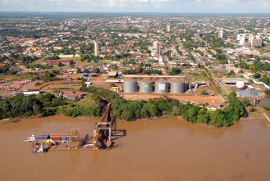Overview
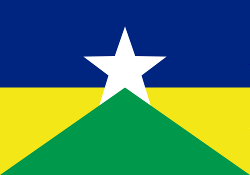
State Flag of Rondônia
Porto Velho is located in the western part of Brazil, not too far from the Bolivian border. It sits as an island of civilization in the middle of what is largely jungle. Only one main highway connects the city with the rest of Brazil. Because of this, the majority of visitors come by air. Another highway—accessed via ferryboar—begins on the other side of the Madeira River and continues into the vastness of the Amazon, eventually connecting to the Trans-Amazon Highway and giving access to several small towns out in the jungle. At many times and in many places, this Amazonian highway is nearly impassible, and so is not used as a major arterry.
Many cargo barges dock at facilities along the shore in and near Porto Velho. At times, the local road that follows the river can be nearly choked with semi-trailers waiting to load or unload. In recent years, this road was finally paved for several miles along the river. Still, the streets in a number of neighborhoods in the city remain dirt. In many ways, Porto Velho continues to have the feeling of a frontier town.
The region is also known for the huge variety of fruit that grows naturally.
Climate
Porto Velho is located in the jungle. As a result, the humidity tends to be quite high. This does have some moderating effect on the temperature, but the overall sensation can actually be more stifling than a dry heat. Mold and mildew are facts of life. People keep items susceptible to mold and humidity damage in “hot boxes”; usually wooden boxes with a low-wattage light bulb to keep the interior warm and to dry out the contents of the box.
One thing that surprises people is the fact that nights tend to cool down. This is because of the evaporative cooling effect of jungle vegetation. It is the same principle that is used in swamp coolers in the Arizona desert. Water “perspired” from trees evaporates, absorbing a small amount of heat energy. This causes the now-cooled air to sink, drawing in more air from above, where the evaporative process continues. This heavier air ends up blowing out from under the trees, creating a cooling breeze. Visitors often go to sleep at night with only a sheet, only to wake up sometime after midnight wanting to add a blanket.
Given the proximity to the equator, temperatures vary little between winter and summer, save that in the winter, cold fronts called friagens can blow in from the south, bringing rain without thunder and lightning, and sharply lowered temperatures. In general, people think in terms of Rainy Season and Dry Season. In Rainy Season, you can expect rain just about every day. Often heavy rain. Puddles form on dirt roads and do not disappear for months. Clothing becomes difficult to dry. Workers have to mow constantly to keep up with the grass growth.
Thus it comes as a surprise just how dry it can get during Dry Season. One would never imagine that the grass could actually turn brown, but it does. Dirt roads turn dusty. In addition, many years also have what we call “Smoke Season”, where farmers all over the region burn the stubble off their fields to get them ready for new crops. Some years, the smoke can cover the sky for weeks on end, turning the air into a respiratory hazard and leaving one feeling suffocated in the dry, smoky heat.
But Rainy Season does come around again, and the smoke goes away, and the cycle repeats itself for yet another year.
Transportation
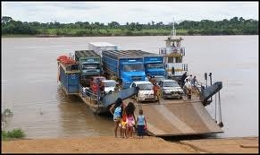
In spite of being a frontier town, most of the streets in Porto Velho are paved. The exceptions are some of the peripheral neighborhoods and roads. Although not as busy as Brasília or São Paulo or other major cities, there is still a fair amount of traffic, especially in the downtown areas. And of course there is public transportation, both taxis and city buses.
Only a few highways connect Porto Velho with the rest of the world, and of those few, only one leads to the interior and beyond. The condition of these roads varies. After repair construction, they are generally in pretty good shape. However, after several months of Rainy Season, they become full of large potholes and travel can become slow and difficult.
There is a (relatively) small rodoviária (inter-city bus station), where you can catch buses to places as far as Cuiabá and beyond. Other lines take you to the Bolivian border and towns along the way.
Since Porto Velho is on a river, boat transportation is also available. A regular ferry boat transports people and vehicles across the river to the road that leads into the state of Amazonas. Barges carry cargo between Porto Velho and cities further downriver. Other boats carry passengers to those locations.
Finally, there is a small international airport. The “international” part being flights to a few South American cities outside of Brazil. There is also a Brazilian Air Force base, which brings a lot of military air traffic.
Bumpy Roads
This is a song that I wrote in the early 1990's as a parody of Country Roads by John Denver. It sort of describes life in Porto Velho. Enjoy!
It ain't heaven, Porto Velho.
Big mosquitoes. Fuzz-mold on your hard disk.
Lots of lizards underneath the logs.
When I take a shower, I step on all the frogs.
Bumpy Roads, take me home, to the place I belong!
Porto Velho, Jungle Mama. Take me home, Bumpy Roads.
All the potholes, and the speed bumps.
Leave today, you get there by tomorrow.
Green and steamy; storm clouds in the sky.
Musty taste of mildew. Clothes that never dry.
Bumpy Roads, take me home, to the place I belong!
Porto Velho, Jungle Mama. Take me home, Bumpy Roads.
I hear the monkeys in the morning out as they call to me.
Thunderstorm reminds me I left my clothes out on the line.
And driving down the road I get the feeling that my shocks had worn out
Yesterday. Yesterday…
Bumpy Roads, take me home, to the place I belong!
Porto Velho, Jungle Mama. Take me home, Bumpy Roads.
Take me home, Bumpy Roads.
Take me home, Bumpy Roads.
Shopping and Services
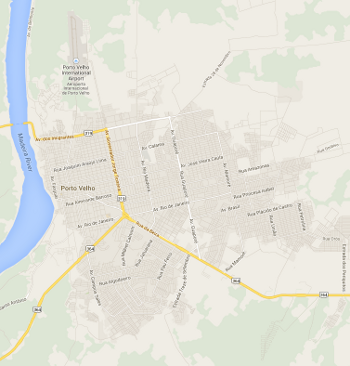
Map of Porto Velho
Being a frontier town, Porto Velho is not noted for a lot of malls and modern shopping facilities. There is one very new mall called Porto Velho Shopping. In addition, there are many regular stores, both in the downtown area and in outlying neighborhoods. There are also several grocery stores. You can even find a pretty good pizza restaurant and ice cream store.
A lot of people tend to go to the feira to buy fruits and vegetables, since they are generally fresher and cheaper than in supermarkets. This is a covered area where vendors set up stands to sell their produce.
Telephone and Internet service are average. In town, they are fairly decent, but in more rural sections they are not as reliable. You will not find the same kind of data speed that you will find in larger cities closer to the population centers of Brazil. A related problem is cable theft. There are thieves who will cut and steal whole sections of telephone cable in order to melt it down and extract the copper to sell.
Cell phones are also popular, as everywhere in Brazil. When they first arrived in Porto Velho, cell phone companies sold nearly ten times the number of units than the infrastructure could handle, and it was quite common to not be able to place a call. Over time, that has improved, and cell phone service is fairly reasonable today.
Electric power is not very reliable, at least in outlying areas. Part of this comes from bad practices by clients who tap into the power lines without setting up the proper safety devices, such as fuses, or who leave wires to dangle and short out or fall on the ground. Another problem is wet tree limbs falling on power lines and causing short circuits; vegetation grows like gangbusters in the humid tropical environment. Even animals such as monkeys will sometimes touch two high-voltage cables and cause a short circuit, blowing fuses. It is not unknown to see a carbonized monkey corpse swinging from a high-tension line for months, its hands locked into gripping position, until it finally decays to the point of falling loose.
Another factor is the fact that the Madeira River rises dramatically during Rainy Season. Many years it will flood the streets and roads that run along its shore, forcing residents to seek other ways to get to town. When this happens, and there is a problem with a utility line, there is usually little that the phone or power company can do about it until the water recedes. It is not unknown to have to go for weeks without city power or even without telephone or Internet service.
Lastly, lightning is common during Rainy Season, and unless you install good protection for your electronic devices, damage will probably occur at some point in time.
Over the years, things have improved. But the jungle conditions are a challenge to maintaining a high-tech civilization in places such as this.
SIL Presence and Activity
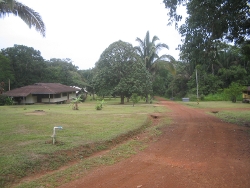
SIL Center in Porto Velho
Because of the presence of many indigenous groups in the area, SIL Brazil has had a translation center in Porto Velho for many years. It is located north of town just off of Estrada do Belmont, which runs alongside the Madeira River. The center contains administrative and service buildings, along with member housing and housing for guests, including special housing for indigenous helpers who come to work with translators. The general layout is circular, with a valley in the middle and two entrances.
While there is a Department of Aviation, there are no flight facilities on the center. Instead, the SIL plane is housed near the airport, in a private hangar, and uses the commercial runway for takeoff and landing.
The center uses an intermediate-voltage three-phase electrical system to distribute power. In the generator shed—where the backup power generator is also located, hence the name—high-tension is stepped down to 2400 volts and transmitted via buried cables. At various locations, transformer boxes tap into the 2400-volt system and further step it down to standard 120-volt house current.
Unlike in most of Brazil, each building does not have it's own water tank. Instead, there is a central water tower located at the highest point on the center. It is filled from a nearby well. The well is not deep; the water table is fairly close to the surface.
In the late 1990's, a corporate grant enabled SIL to install a fiber-optic computer network that links all of the buildings to a central switch. This allows for center-wide Internet access and access to the file server. Since it uses light instead of electricity, fiber-optic is not directly subject to lightning damage, which is a big plus.
For most of its history, the Porto Velho center was not associated with entity-level administration. However, when the headquarters offices closed in Brasília in the mid-1990's, the Language Programs Department moved out to the center here. It stayed until the administration moved to Anápolis in 2008.
For more about trips that I made to Porto Velho to provide service to our members there, see one of the following work trip reports.
In 2006, due to reduced need and diminishing numbers of members living in Porto Velho, approximately three-quarters of the center was sold to a pair of neighboring organizations. Of the 3 main office buildings, SIL kept one and sold the other two. Beyond that, SIL kept several houses and the aviation building. Since it was not possible to separate the electrical and water systems, SIL and the other organizations ended up sharing responsibility. The fiber-optic network was more manageable; although the cables still run through all parts of the center, it was possible to separate the buildings of the various organizations by rearranging connections to the central fiber-optic switches, and then disconnecting the switches from one another.
The current reduced Porto Velho center still serves a few translation projects. There are no plans at this point to close the remaining facilities.
Partner Organizations
Two other organizations have centers next to the SIL center in Porto Velho. One is JOCUM, or the Brazilian version of YWAM. “JOCUM” stands for JOvens Com Uma Missão, which is the exact translation of “Youth With A Mission” into Portuguese. Although SIL does not work closely with JOCUM, there are indigenous projects where personnel from both organizations overlap. And JOCUM is one of the organizations that bought part of the three-quarters of the center that was sold off in 2006. Therefore, both organizations share resources, such as the water and electrical infrastructures, and administer them jointly. Over the years, as the SIL presence in Porto Velho has diminished, JOCUM has grown. And although the name is “Youth” With A Mission, many members are older. While SIL focuses on linguistics and translation, JOCUM's interests are much more varied.
The other organization is called Missão Evangélica Unida, and is primarily German. Like SIL, they work with indigenous peoples, but do not focus on translation as does SIL. Since their first arrival in Porto Velho in the mid-1990's, their presence has grown considerably. Like JOCUM, they participated in the purchase of the three-quarters of the center that SIL sold in 2006. While SIL does not work closely with MEU, there are common interests, and possible future cooperation on projects.
Area Tourism
Porto Velho is not much of a tourist town. There is very little to see, other than a few minor attractions upriver, and some exhibits from the railroad building era. There is decent fishing in the area, though you don't want to eat fish caught from the Madeira River itself, due to mercury pollution from gold mining.
Porto Velho is a working town. It is also an access point for traffic into the Amazon, plus a few towns even further west and the Bolivian border. But in general, people do not come here for tourism.
